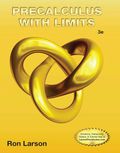
a.
Represent annual sales with the slopes of lines.
a.
Answer to Problem 88E
Explanation of Solution
Given information:
The graph shows the sales (in billions of dollars) for Apple Inc. in the years
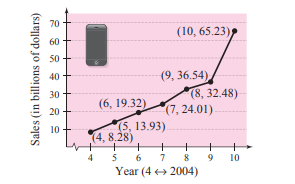
Use the slopes of the line segments to determine the years in which the sales showed the greatest increase and the least increase.
Calculation:
Consider The graph shows the sales (in billions of dollars) for Apple Inc. in the years

The slope
Now consider each point given in the graph,
Slope between points
Slope between points
Slope between points
Slope between points
Slope between points
Slope between points
Hence for years
sales has greatest increase
b.
Represent annual sales with the slopes of lines.
b.
Answer to Problem 88E
Slope of line connecting the points for year
Explanation of Solution
Given information:
The graph shows the sales (in billions of dollars) for Apple Inc. in the years
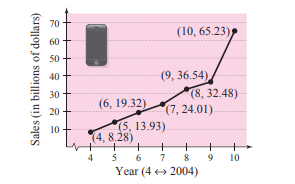
Find the slope of the line segment connecting the points for the years
Calculation:
Consider The graph shows the sales (in billions of dollars) for Apple Inc. in the years
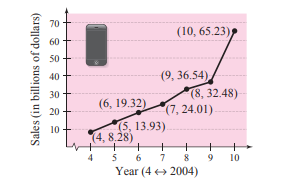
The slope
Slope of line connecting the points
Hence Slope of line connecting the points for year
c.
Represent annual sales with the slopes of lines.
c.
Answer to Problem 88E
The slope in part
Explanation of Solution
Given information:
The graph shows the sales (in billions of dollars) for Apple Inc. in the years
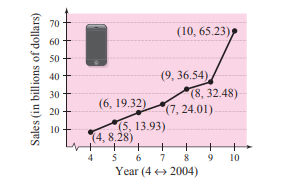
Interpret the meaning of the slope in part
Calculation:
The slope in part
Hence the slope in part
Chapter 1 Solutions
EBK PRECALCULUS W/LIMITS
- A 20 foot ladder rests on level ground; its head (top) is against a vertical wall. The bottom of the ladder begins by being 12 feet from the wall but begins moving away at the rate of 0.1 feet per second. At what rate is the top of the ladder slipping down the wall? You may use a calculator.arrow_forwardExplain the focus and reasons for establishment of 12.4.1(root test) and 12.4.2(ratio test)arrow_forwarduse Integration by Parts to derive 12.6.1arrow_forward
- Explain the relationship between 12.3.6, (case A of 12.3.6) and 12.3.7arrow_forwardExplain the key points and reasons for the establishment of 12.3.2(integral Test)arrow_forwardUse 12.4.2 to determine whether the infinite series on the right side of equation 12.6.5, 12.6.6 and 12.6.7 converges for every real number x.arrow_forward
- use Corollary 12.6.2 and 12.6.3 to derive 12.6.4,12.6.5, 12.6.6 and 12.6.7arrow_forwardExplain the focus and reasons for establishment of 12.5.1(lim(n->infinite) and sigma of k=0 to n)arrow_forwardExplain the focus and reasons for establishment of 12.5.3 about alternating series. and explain the reason why (sigma k=1 to infinite)(-1)k+1/k = 1/1 - 1/2 + 1/3 - 1/4 + .... converges.arrow_forward
 Calculus: Early TranscendentalsCalculusISBN:9781285741550Author:James StewartPublisher:Cengage Learning
Calculus: Early TranscendentalsCalculusISBN:9781285741550Author:James StewartPublisher:Cengage Learning Thomas' Calculus (14th Edition)CalculusISBN:9780134438986Author:Joel R. Hass, Christopher E. Heil, Maurice D. WeirPublisher:PEARSON
Thomas' Calculus (14th Edition)CalculusISBN:9780134438986Author:Joel R. Hass, Christopher E. Heil, Maurice D. WeirPublisher:PEARSON Calculus: Early Transcendentals (3rd Edition)CalculusISBN:9780134763644Author:William L. Briggs, Lyle Cochran, Bernard Gillett, Eric SchulzPublisher:PEARSON
Calculus: Early Transcendentals (3rd Edition)CalculusISBN:9780134763644Author:William L. Briggs, Lyle Cochran, Bernard Gillett, Eric SchulzPublisher:PEARSON Calculus: Early TranscendentalsCalculusISBN:9781319050740Author:Jon Rogawski, Colin Adams, Robert FranzosaPublisher:W. H. Freeman
Calculus: Early TranscendentalsCalculusISBN:9781319050740Author:Jon Rogawski, Colin Adams, Robert FranzosaPublisher:W. H. Freeman
 Calculus: Early Transcendental FunctionsCalculusISBN:9781337552516Author:Ron Larson, Bruce H. EdwardsPublisher:Cengage Learning
Calculus: Early Transcendental FunctionsCalculusISBN:9781337552516Author:Ron Larson, Bruce H. EdwardsPublisher:Cengage Learning





